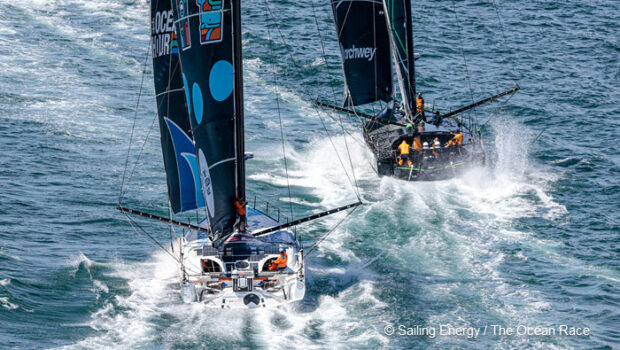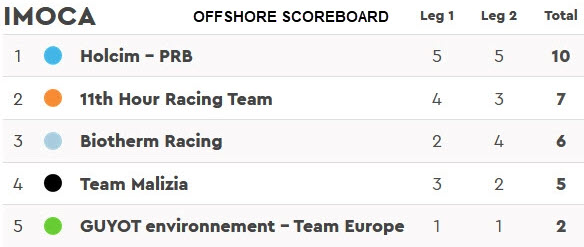Big decisions for The Ocean Race teams
Published on February 26th, 2023
Cape Town, South Africa (February 26, 2023) – The longest stage in the 50-year history of The Ocean Race – 12,750 nautical miles from Cape Town in South Africa to Itajai in Brazil – got underway with a big decision for navigators and skippers.
The key question is whether to stay close to the shore going past the Cape of Good Hope, or head further south – or even southwest – in the hunt for bigger breeze and the first of the westerlies that will take the five IMOCAs east towards Australia.
Christian Dumard, the official weather consultant for The Ocean Race, says if one crew decides to head south, the others may well follow suit for fear of missing a trick. He says the leg will start with strong upwind conditions on Sunday evening, then there is the possibility of a split.
“The boats could go upwind and go quite close to the Cape of Good Hope, but some could reach off to the southwest and go and get the windshift (south-east to southwest) in the high pressure system. They will not like having a negative VMG, but if one or two boats go southwest, the others could follow,” said Dumard.
There is an interesting precedent for this deep in the history of The Ocean Race back in 1997, when the Whitbread 60, Swedish Match, skippered by Gunnar Krantz, split from the fleet after leaving Table Bay and headed offshore alone. The move produced a 35-mile lead over the chasing pack by midnight on the first day and an eventual leg victory at Fremantle in Australia 15 days later.
Dumard says the early stages of this epic modern-day stage to Cape Horn and then Brazil, will be all about getting south and into the westerly winds that howl around the bottom of the globe through the Southern Ocean, offering super-fast but hugely uncomfortable surfing conditions for the IMOCA crews.
“If we look in the longer term, there is a low pressure system on 2 and 3 of March,” explained Dumard. “The position of this low pressure, and how deep it will be, still varies quite a bit, depending on the models.
“For now, the idea is to get south and into the westerlies as soon as possible. If the low moves further south than expected, then there could be other options to go north of the low – for me, it looks more likely to be the southern option, but the game is still open and it could still change.”
The leg overall is likely to see a mix of conditions, with areas of light winds spreading south across the racetrack, but also storms which could be violent, as Dumard warns. “It is the cyclone season in the Indian and Pacific Oceans, so we have had a lot of tropical storms recently and, when they are in phase with a frontal system – when they are caught in a front of a low pressure system – then they can become very active again.”
But while this leg will be dominated by big winds in the ‘South’, the podium order may well be settled by what happens after Cape Horn, not before it. Dumard says this is going to be a challenging part of the race, as the crews cross weather systems, with numerous of transitions to get right.
“It’s probably the most difficult part of the leg,” he said. “We talk about the southern oceans which are not easy, but then you have low pressure systems coming from Brazil, and high pressure coming quickly behind them, and the boats are not moving with the systems but across them, so conditions change very quickly.”
Then the final hours into Itajai could be a lottery. “At Itajaì, you can have light winds, thunderstorms, rain squalls, anything can happen on the way to the finish,” summarized Dumard.
Race director Phil Lawrence, meanwhile, is keeping an eye on iceberg activity and encroachments of colder water onto the course. The leg features a constant ice exclusion zone, designed to keep the crews away from bergs and smaller chunks of ice that could badly damage an IMOCA traveling at high speed.
Lawrence says the northern limit of the zone will be under review, especially in the eastern Pacific on the way towards Cape Horn.
“Whilst the leg is running, we will be carrying out further scans of the Pacific, and it is highly likely that we will make adjustments to the ice limit as necessary,” he said. “Either moving it up, if we identify risk, or moving it down if we see that it is safe.
“At the moment, there is an unusual situation in the eastern Pacific, where there is a lot of ice activity quite far north, so our present limit has got quite a bulge in its profile. But we will do some more scans and maybe we can bring it further south in the weeks to come.”
Lawrence says The Ocean Race HQ team was impressed by the generally good condition of the boats when they arrived at Cape Town at the end of Leg 2. He is well aware, however, that this leg could produce unwelcome setbacks for boats suffering damage in big seas.
“On every leg of the course, we have a big contingency plan, not just on the Southern Ocean leg,” he explained. “So we have already pre-planned the leg with all the marine rescue co-ordination centers, and we have identified ports of refuge all along the route where boats could go in the event they need to divert.”
One factor that the crews will be wary of in the early stages of this leg, is the danger of hitting debris in the water south of the Cape of Good Hope, an area of ocean that has been a source of problems for IMOCAs in the past and Jules Verne crews too.
In this race Lawrence says a protocol is in place to ensure that if any crews either hit or encounter debris in the water, they will notify Race HQ immediately so the details can be quickly shared with the rest of the fleet.
Race details – Route – Tracker – Teams – Content from the boats – YouTube
IMOCA: Boat, Design, Skipper, Launch date
• Guyot Environnement – Team Europe (VPLP Verdier); Benjamin Dutreux (FRA)/Robert Stanjek (GER); September 1, 2015
• 11th Hour Racing Team (Guillaume Verdier); Charlie Enright (USA); August 24, 2021
• Holcim-PRB (Guillaume Verdier); Kevin Escoffier (FRA); May 8, 2022
• Team Malizia (VPLP); Boris Herrmann (GER); July 19, 2022
• Biotherm (Guillaume Verdier); Paul Meilhat (FRA); August 31 2022
The Ocean Race 2022-23 Race Schedule:
Alicante, Spain – Leg 1 (1900 nm) start: January 15, 2023
Cabo Verde – ETA: January 22; Leg 2 (4600 nm) start: January 25
Cape Town, South Africa – ETA: February 9; Leg 3 (12750 nm) start: February 26
Itajaí, Brazil – ETA: April 1; Leg 4 (5500 nm) start: April 23
Newport, RI, USA – ETA: May 10; Leg 5 (3500 nm) start: May 21
Aarhus, Denmark – ETA: May 30; Leg 6 (800 nm) start: June 8
Kiel, Germany (Fly-By) – June 9
The Hague, The Netherlands – ETA: June 11; Leg 7 (2200 nm) start: June 15
Genova, Italy – The Grand Finale – ETA: June 25, 2023; Final In-Port Race: July 1, 2023
The Ocean Race (formerly Volvo Ocean Race and Whitbread Round the World Race) was initially to be raced in two classes of boats: the high-performance, foiling, IMOCA 60 class and the one-design VO65 class which has been used for the last two editions of the race.
However, only the IMOCAs will be racing round the world while the VO65s will race in The Ocean Race VO65 Sprint which competes in Legs 1, 6, and 7 of The Ocean Race course.
Additionally, The Ocean Race also features the In-Port Series with races at seven of the course’s stopover cities around the world which allow local fans to get up close and personal to the teams as they battle it out around a short inshore course.
Although in-port races do not count towards a team’s overall points score, they do play an important part in the overall rankings as the In-Port Race Series standings are used to break any points ties that occur during the race around the world.
The 14th edition of The Ocean Race was originally planned for 2021-22 but was postponed one year due to the pandemic, with the first leg starting on January 15, 2023.
Source: Ed Gorman, IMOCA










 We’ll keep your information safe.
We’ll keep your information safe.